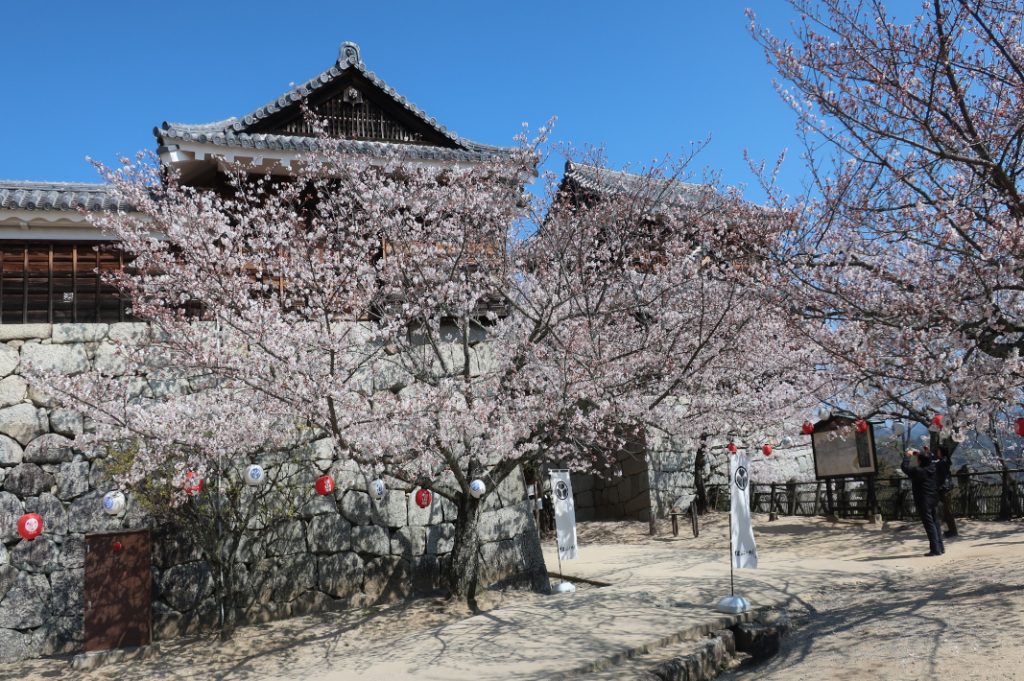I’ve never been much of a bicycle rider, but the course along the Shimanami Kaido (Island Wave Sea Highway) makes me wish I was. Every year in late fall, the highway that connects Shikoku to the mainland floods with cyclists. Participants travel from the Eastern Shores of Shikoku to the town of Onomichi. While our general lack of experience prevented us from following one of the cycling courses (the Shimanami Kaido) across the Seto Inland Sea, the 6th day of our cross-Japan trek took us on a similar path and ended up being nearly as much of a marathon.
Touring Matsuyama Castle in Shikoku
Matsuyama castle is one of the “Twelve Original Castles” that have survived from the feudal era without sustaining major damage. Built in 1603, the castle occupies a vantage point looking out straight across the Seto Inland Sea. Matsuyama Castle’s position atop Katsuyama aided its survival, and its history is intertwined with that of the city below. With time to spare before our train departed we decided to pay a visit. Unfortunately, we underestimated the effort required to get to the top.
The walking trail to Matsuyama Castle is paved and not particularly strenuous. This made it all the more embarrassing when we found ourselves winded a quarter of the way up. We told ourselves it was simply because we tackled another mountain two days earlier. Perhaps its more honest to suggest we were simply out of shape. After trudging our way to the top, we waded through a sea of amateur photographers trying to catch the perfect photo of cherry blossoms from the fortress walls.

Inside, castle curators have struck a balance between recreating the conditions of Edo-era life in Matsuyama castle, and offering a more museum-like experience. In addition to display cases filled with relics, visitors can try their hand at wielding medieval weaponry and visit rooms wreathed in fake torch flame.
A Race to the Bottom
We left the castle a little before noon and agreed that we were not prepared for another mountain hike. With two transportation options from the top, we decided to make a race of it. My fiancée was determined to take the comfortably enclosed cable car. I opted for the somewhat more precarious chairlift seats. With no safety bar, there was little to keep me from tumbling onto the netting below, but I thought the lightweight and sleek design—not to the mention the five-minute head start—would give me the natural advantage. Unfortunately, I was less than a quarter of the way down the mountain when I saw the glass car zipping down the steel cable beside me. I ignored the smug look on my fiancée’s face when I finally reached the bottom.
The Many Islands of the Shimanami Kaido
After a quick food truck meal in the middle of Matsuyama, we caught a train from Matsuyama to Imabari. From there, the road to the main-land cut across the sea, but the train did not. Instead, we would be taking the bus. With tickets in hand, we traveled across a series of bridges before arriving at our destination two hours later.
The main portion of the Shimanami Kaido traverses six small islands between Shikoku and Honshu and overlooks several others. It’s one of the only bridges between Shikoku and the mainland, and the only one that allows pedestrians and cyclists to make the trip. The cycling route is slightly different, taking travelers to more islands and visiting several towns and campsites.
If traveling between Imabari and Onomichi (part of the Shimanami Kaido), you will have to transfer at a road stop shortly before the mainland. If you miss the transfer, as we did, you’ll have to kill time in the gift shop/restaurant complex stationed before the last quarter of your journey. We had already eaten lunch, and it was too early for dinner. There was nothing to do but tour the gift shops. I found my gaze transfixed by a smiling bridge-shaped plushie, and it stared back vacantly. It didn’t appear to be the mascot of the highway or even the island we were on. As far as I could tell, it was the personification of the bridge itself. For the close to 30 minutes I pondered the mysteries of Japanese mascot culture, until a stampede of travelers suggested it was time to catch the bus.
The Narrow Streets of Onomichi
Shortly before our departure, a friend insisted we visit Onomichi, describing it as a mix between a European town and a city in a Ghibli film. We arrived just as the sun was setting and were happy to discover that he wasn’t far off.
The town is built along the side of the mountain and comprised of narrow winding streets bracketed by stone walls. After checking into an old converted boarding house from the 1960s, we made our way through the quickly darkening streets. It quickly became clear that the city belonged to cats more than humans. They sat atop of every wall and waited around every corner. Some ran off at the sight of yet another tourist, but most were happy for any attention that came their way.
By that point, the rush was over. We were content with having navigated the Shimanami Kaido and followed the trail of cats from one temple to the next. Eventually we found our way to a restaurant for two bowls of Onomichi’s signature ramen, and then trudged back to the guesthouse and promptly passed out.
Name: Shimanami Kaido
Address: 5-6 Dogoyunomachi, Matsuyama, Ehime 790-0842, Japan
URL: https://shimanami-cycle.or.jp/go-shimanami/
Post by Japan Journeys.